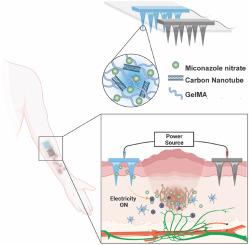Electrically-driven drug delivery into deep cutaneous tissue by conductive microneedles for fungal infection eradication and protective immunity
IF 12.9
1区 医学
Q1 ENGINEERING, BIOMEDICAL
引用次数: 0
Abstract
Fungal infections affect over 13 million people worldwide and are responsible for 1.5 million deaths annually. Some deep cutaneous fungal infections may extend the dermal barriers to cause systemic infection, resulting in substantial morbidity and mortality. However, the management of deep cutaneous fungal infection is challenging and yet overlooked by traditional treatments, which only offer limited drug availability within deep tissue. In this study, we have developed an electrically stimulated microneedle patch to deliver miconazole into the subcutaneous layer. We tested its antifungal efficacy using in vitro and ex vivo models that mimic fungal infection. Moreover, we confirmed its anti-fungal and wound-healing effects in a murine subcutaneous fungal infection model. Furthermore, our findings also showed that the combination of miconazole and applied current synergistically stimulated the nociceptive sensory nerves, thereby activating protective cutaneous immunity mediated by dermal dendritic and γδ-T cells. Collectively, this study provides a new strategy for minimally invasive delivery of therapeutic agents and the modulation of the neuro-immune axis in deep tissue.

通过导电微针将药物输送到深层皮肤组织,以根除真菌感染和保护性免疫。
真菌感染影响着全球 1300 多万人,每年造成 150 万人死亡。一些深层皮肤真菌感染可能会突破皮肤屏障,引起全身感染,导致严重的发病率和死亡率。然而,深层皮肤真菌感染的治疗极具挑战性,而传统疗法却忽视了这一点,因为传统疗法只能在深层组织内提供有限的药物。在这项研究中,我们开发了一种电刺激微针贴片,可将咪康唑送入皮下层。我们使用模拟真菌感染的体外和体内模型对其抗真菌功效进行了测试。此外,我们还在小鼠皮下真菌感染模型中证实了它的抗真菌和伤口愈合效果。此外,我们的研究结果还表明,咪康唑和外加电流的组合能协同刺激痛觉神经,从而激活由真皮树突状细胞和 γδ-T 细胞介导的保护性皮肤免疫。总之,这项研究为微创递送治疗药物和调节深层组织的神经免疫轴提供了一种新策略。
本文章由计算机程序翻译,如有差异,请以英文原文为准。
求助全文
约1分钟内获得全文
求助全文
来源期刊

Biomaterials
工程技术-材料科学:生物材料
CiteScore
26.00
自引率
2.90%
发文量
565
审稿时长
46 days
期刊介绍:
Biomaterials is an international journal covering the science and clinical application of biomaterials. A biomaterial is now defined as a substance that has been engineered to take a form which, alone or as part of a complex system, is used to direct, by control of interactions with components of living systems, the course of any therapeutic or diagnostic procedure. It is the aim of the journal to provide a peer-reviewed forum for the publication of original papers and authoritative review and opinion papers dealing with the most important issues facing the use of biomaterials in clinical practice. The scope of the journal covers the wide range of physical, biological and chemical sciences that underpin the design of biomaterials and the clinical disciplines in which they are used. These sciences include polymer synthesis and characterization, drug and gene vector design, the biology of the host response, immunology and toxicology and self assembly at the nanoscale. Clinical applications include the therapies of medical technology and regenerative medicine in all clinical disciplines, and diagnostic systems that reply on innovative contrast and sensing agents. The journal is relevant to areas such as cancer diagnosis and therapy, implantable devices, drug delivery systems, gene vectors, bionanotechnology and tissue engineering.
 求助内容:
求助内容: 应助结果提醒方式:
应助结果提醒方式:


